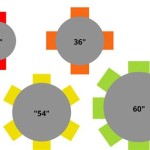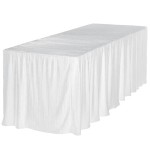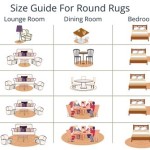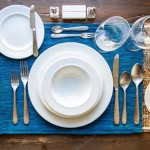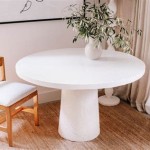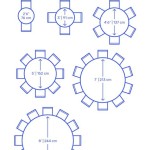Proper Use of Table Napkins in Schools: A Guide to Etiquette and Hygiene
Table manners are a fundamental aspect of social grace and civilized interaction, and the ability to use a table napkin correctly is a key element of this skill. In schools, teaching proper napkin etiquette serves a dual purpose: it promotes hygiene and reinforces the importance of respecting mealtime traditions. This article will delve into the proper usage of table napkins in a school setting, covering everything from initial placement to appropriate uses and common faux pas to avoid. Understanding these principles will empower students with the confidence to navigate dining situations with poise and consideration for others.
The emphasis on table napkin usage in schools also contributes to setting a standard for cleanliness. By establishing consistent expectations, schools cultivate a positive environment where hygiene is prioritized, fostering healthy habits that extend beyond the cafeteria or dining hall.
Initial Placement and Use of the Table Napkin
The first step in proper napkin etiquette involves knowing when and how to handle the napkin upon being seated. Generally, the table napkin is found either folded on the plate, to the left of the plate, or sometimes elegantly arranged in a glass or holder. Regardless of its initial positioning, once a student is seated, the napkin should be unfolded and placed in the lap. This simple act signals a readiness to begin the meal and serves the practical purpose of protecting clothing from accidental spills.
Smaller napkins, often found at informal lunches or snack times, can be fully unfolded. Larger napkins, typical for more formal meals, should be unfolded halfway, with the crease running towards the body. This allows for a generous surface area to catch crumbs and wipe hands effectively.
Timing is also crucial. The napkin should be placed in the lap shortly after everyone at the table is seated, or after the host or teacher gestures that it is appropriate to begin. Waiting for a cue ensures that the group starts the meal together respectfully. Students should avoid immediately grabbing the napkin upon sitting down, as this can be perceived as overly eager and impolite.
If a student needs to leave the table temporarily during the meal, the napkin should not be placed on the chair. Instead, it should be loosely folded and placed to the left of the plate. This indicates to the staff or peers that the student intends to return and prevents the chair from becoming soiled. Upon returning to the table, the student should retrieve the napkin and replace it in their lap.
Appropriate Uses of the Table Napkin During the Meal
Beyond its initial placement, the table napkin serves several important functions throughout the meal. Its primary purpose is to maintain cleanliness and hygiene. Students should use the napkin to gently blot their mouths after taking a bite, especially after eating something messy or saucy. This prevents food residue from transferring onto glasses, utensils, or other surfaces.
The napkin is also invaluable for handling minor spills or mishaps. If a student accidentally spills a drink or drops food, the napkin should be used to quickly and discreetly clean up the mess. Blotting is preferable to wiping, as wiping can spread the stain. If the spill is significant, the student should politely request assistance from a teacher or staff member.
Students should also use the napkin to discreetly wipe their fingers if they become sticky or soiled. Avoiding the use of sleeves, the tablecloth, or other inappropriate surfaces is essential. A quick and subtle dab with the napkin is all that is required to address the issue.
It is important to emphasize that the napkin is not a multi-purpose tool. It should not be used to blow one’s nose, clean silverware, or polish glasses. These actions are considered impolite and unhygienic. If a student needs to blow their nose, they should excuse themselves from the table and use a tissue in the restroom.
Encouraging consistent and appropriate napkin usage during meal times reinforces the importance of hygiene and respectful dining habits. By adhering to these guidelines, students contribute to a cleaner and more pleasant environment for everyone.
Common Napkin Etiquette Faux Pas and How to Avoid Them
While the basic principles of napkin etiquette are straightforward, there are several common mistakes that students often make. Understanding these faux pas and learning how to avoid them is crucial for mastering proper dining etiquette.
One frequent error is using the napkin as a bib. While it is tempting to tuck the napkin into the collar, especially for younger students, this is generally considered inappropriate. The napkin should always remain in the lap, unless it is temporarily placed on the table when leaving the seat.
Another common mistake is overusing the napkin. Some students may excessively wipe their mouths after every bite, which can be distracting and appear overly fastidious. The napkin should be used judiciously, only when necessary to blot or clean up small spills.
Leaving a heavily soiled napkin on the table at the end of the meal is also considered impolite. While it is understandable that the napkin may have some food stains, excessively dirty napkins can be off-putting. If the napkin is particularly soiled, it can be loosely folded to conceal the messier parts.
Students should also avoid crumpling the napkin into a ball at the end of the meal. A loosely folded napkin placed to the left of the plate indicates that the student has finished eating. Crumpling the napkin can suggest that the meal was unpleasant or that the student is simply being careless.
Finally, it's important to reiterate that the napkin is not a substitute for proper hygiene practices outside of meal times. Students should still wash their hands thoroughly before and after eating, regardless of how diligently they use their napkins. Emphasizing the importance of overall hygiene is crucial to promote healthy habits that extend beyond the dining table.
By addressing these common mistakes and providing clear guidelines, schools can equip students with the knowledge and skills necessary to confidently navigate dining situations with proper napkin etiquette. This instills a sense of decorum and respect for both oneself and others. Proper use of the table napkin in school is a critical element of overall social and life skills that will benefit students far beyond the classroom.
Educating students on the correct way to handle a table napkin contributes significantly to their development as respectful and considerate individuals. It is a small but significant part of cultivating a sense of social grace and responsibility. From initial placement in the lap to discreetly blotting one's mouth, each action reinforces the importance of hygiene, courtesy, and mindful participation in shared dining experiences. This helps lay the foundation for students to feel comfortable and confident in various social settings, showcasing their ability to navigate mealtime etiquette with poise and integrity.

8 Ways To Use A Napkin With Proper Table Etiquette Wikihow

What Side Of The Plate Do You Place Napkin On When Setting A Table Ehow

8 Ways To Use A Napkin With Proper Table Etiquette Wikihow

Table Etiquette The Place Setting Rooted In Foods

27 Napkin Fold Ideas

Table Etiquette The Place Setting Rooted In Foods

Table Manners The Napkin Rooted In Foods

How To Set A Table For Casual And Formal Dining

How To Set A Proper Table Dishing With Diane

Do Napkins Go On The Left Or Right
Related Posts

